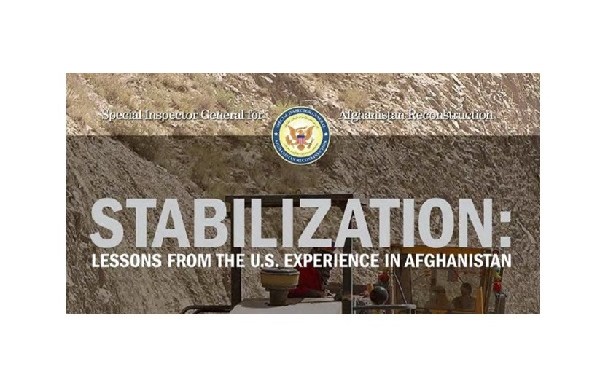
The SIGAR stabilization lessons learned report on Afghanistan was published on Thursday, May 24, 2018. The report by the Special Inspector General for Afghanistan Reconstruction examines the 17 year-long effort to help the Afghan government stabilize rural communities and to win the hearts and minds of the Afghan population. This project takes a close look at the various stabilization efforts and programs that the U.S. government implemented in Afghanistan and identifies lessons observed (and learned) and provides recommendations for future efforts in Afghanistan and other similar conflicts.
The report found that between 2001 and 2017, U.S. government efforts to stabilize insecure and contested areas in Afghanistan mostly failed.
Report Contents:
- Executive Summary
- Introduction
- Stabilization Takes Shape (2002-2009)
- Origins of the Stabilization Strategy (2009)
- Stabilization Ramps Up for the Surge (2009-2012)
- From Stabilization to Transition (2012-2017)
- DoD Stabilization Programs
- Measuring the Effectiveness of Stabilization
- Analytical Review of Stabilization
- Findings
- Lessons
- Conclusion
- Recommendations
Some of the Findings of SIGAR Stabilization Lessons Learned Report:
- The U.S. government overestimated its ability to build and reform Afghan government institutions and ministries.
- The U.S. spent too much money too quickly in a country ill-prepared to absorb the funds which led to opportunities for vast levels of corruption by Afghan government officials and Afghan contractors.
- Officials from the State Department, USAID, and Department of Defense were not – for the most part – knowledgable of Afghanistan, local institutions, culture, the Afghan government.
- Predatory Afghan government officials, warlords, powerbrokers were enriched through stabilization projects and able to expand their patronage circle and supporters.
- Stabilization efforts focused on the most unsecure districts that were fiercely contested by the Taliban. Generally these efforts failed because of the insecurity in these districts.
These findings above (and many more not listed in this article but found in the report) led to the failure of stabilization efforts in many of the more contested districts of Afghanistan. There are seven key findings in the report.
Village Stability Operations (VSO). The SIGAR stabilization lessons learned report examined a Department of Defense stabilization program called Village Stability Operations (VSO) implemented by special operations forces in Afghanistan. The VSO program was in effect from 2010 to 2014. SIGAR found that the VSO program began “. . . on a solid conceptual footing during the surge . . . “, however, once transition began, the program was compromised on many of its core principles. The Afghan Local Police (ALP) was a core component of the VSO program and proved successful in establishing security in many contested districts. However, some militias were absorbed into the ALP without proper vetting, oversight by US SOF, and as ‘unilateral’ ALP by the Ministry of Interior (MoI). In addition, with the drawdown of U.S. forces SOF oversight, training, and support diminished for the ALP program. The report discusses the VSO and ALP programs in detail on pages 107 to 123.
***
This SIGAR report on stabilization in Afghanistan will be an important reference document for subsequent stabilization efforts in Afghanistan. In addition, it will serve as an important guide for future operations in other areas of the world where the United States attempts to conduct stability and counterinsurgency operations.
Stabilization: Lessons from the U.S. Experience in Afghanistan, May 24, 2018.
The 302-page report is available at the SIGAR web site:
www.sigar.mil/lessonslearned/lessonslearnedreports/index.aspx
***
Photo: The top image is from the cover of the SIGAR report, May 24, 2018.